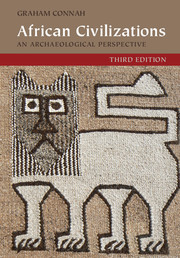Book contents
- Frontmatter
- Dedication
- Contents
- List of figures
- Preface and acknowledgements
- 1 The context
- 2 Origins: social change on the lower Nile
- 3 The Mediterranean frontier: North Africa
- 4 Sudanic genesis: Nubia
- 5 Isolation: the Ethiopian and Eritrean Highlands
- 6 Opportunity and constraint: the West African savanna
- 7 Achieving power: the West African forest and its fringes
- 8 Indian Ocean networks: the East African coast and islands
- 9 Cattle, ivory, and gold: social complexity in Zambezia
- 10 Central Africa: the Upemba Depression, Interlacustrine Region, and Far West
- 11 Settlement growth and emerging polities: South Africa
- 12 What are the common denominators?
- References
- Index
6 - Opportunity and constraint: the West African savanna
Published online by Cambridge University Press: 05 November 2015
- Frontmatter
- Dedication
- Contents
- List of figures
- Preface and acknowledgements
- 1 The context
- 2 Origins: social change on the lower Nile
- 3 The Mediterranean frontier: North Africa
- 4 Sudanic genesis: Nubia
- 5 Isolation: the Ethiopian and Eritrean Highlands
- 6 Opportunity and constraint: the West African savanna
- 7 Achieving power: the West African forest and its fringes
- 8 Indian Ocean networks: the East African coast and islands
- 9 Cattle, ivory, and gold: social complexity in Zambezia
- 10 Central Africa: the Upemba Depression, Interlacustrine Region, and Far West
- 11 Settlement growth and emerging polities: South Africa
- 12 What are the common denominators?
- References
- Index
Summary
In May 2012 the United Nations estimated that 18 million people in the Sahel region of West Africa were suffering from food shortages caused by drought and conflict and that nearly 1.5 million children were near starvation. The Sahel was defined broadly, although technically it is only the driest of the savanna zones south of the Sahara Desert. Nevertheless, how could it be that one of the areas of early urbanization and state formation considered in this book is situated within this apparently disastrous zone? Clearly, its occupants did not always face the bleak situation that now exists. Particularly this seems to have been the case immediately bordering the southern edge of the Sahara, which was the setting for important social and political developments during the first and second millennia AD. Some historical sources indicate conditions that were far from bleak. For example, in the early sixteenth century Leo Africanus said of Jenné, situated in the Inland Niger Delta on the edge of the Sahel zone: ‘This place exceedingly aboundeth with barlie, rice, cattell, fishes, and cotton’ (Africanus 1896: vol. 3, 822). This description was by an outsider, for Leo Africanus came from North Africa, but a local scholar, al-Sa'di, writing in about 1655, wrote: ‘This city is large, flourishing and prosperous; it is rich, blessed and favoured by the Almighty … The area around Jenné is fertile and well populated; with numerous markets held there on all the days of the week’ (al-Sa'di 1964: 22–4). Although it was pointed out that al-Sa'di might have been biased in favour of Jenné (McIntosh and McIntosh 1980: vol. 1, 49), Bovill (1968: 135) thought that this was a ‘convincing tribute’. Thus, it seems from historical sources, oral tradition, and archaeological data as if the West African savanna was in the past a zone that offered opportunities as well as constraints to the people who lived there.
Geographical location and environmental factors
Throughout the history of the human race in Africa, the most important ecosystem in the continent has probably been the savanna. Rich in faunal and floral resources, by the Holocene attractive for both cereal agriculture and livestock rearing, it offered conditions of relatively easy movement in which natural resources and manufactured products could be readily exchanged.
- Type
- Chapter
- Information
- African CivilizationsAn Archaeological Perspective, pp. 149 - 184Publisher: Cambridge University PressPrint publication year: 2015



